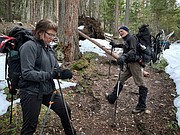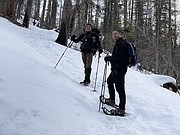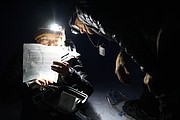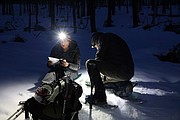In pursuit of rare owls in Glacier National Park
The air is unusually still and only silence flows through the star-lit trees around us as we sit in darkness deep in the forest of Glacier National Park. The temperature has dropped to 20 degrees as midnight approaches while the three of us wait high above Lake McDonald, a few miles up the Lincoln Lake Trail.
Hours of hiking through running water, mud and deep snow might be about to pay off as park biologist Lisa Bate, volunteer Gerard Byrd and I hope to hear of the first signs of the elusive nocturnal species that has drawn us into the forest this evening — great gray and boreal owls.
For two years now, Bate and her colleagues have been striving to gather more information about Glacier’s population of these birds, which are known to live in the park but are rarely seen.
“We just really didn’t know the status of these owl species,” Bate explains. “I get reports of great grays inside the park, but I have only seen one since I have been working here and I have only heard boreal owls three or four times. We are trying to learn how rare they are and if they should be a species of concern, but we just don’t have the answers to those questions right now.”
According to Bate, biologists around Montana really began delving into the mystery of the state’s owl population in 2014 after realizing that a large number of owls species were on the Montana Fish, Wildlife and Parks list of Species of Greatest Inventory Need, meaning little was known about how common the birds were.
After Bate and her team conducted surveys along the Inside North Fork and the Going-to-the-Sun roads, many owl species were able to be dropped from the list. Owls were detected at nearly a third of the 2,000 spots surveyed, but two species were mysteriously missing.
After determining that great gray and boreal owls could be missing because their specific habitat — mature old growth forests with open clearings nearby — were not targeted, a new effort to study them was set to begin in 2020.
“I was literally opening the box with our new automatic recording units (ARUs) in it when I got the call about us having to pack up and work from home because of Covid,” Bate said.
Unable to get permission to conduct surveys while the majority of the park was closed in 2020, Bate and her team began their studies in 2021.
BY PLACING 138 one-square kilometer grid cells throughout the park for the study, Bate hopes to sample two to four grid cells per year, but there are many challenges.
First and foremost is the weather. The very short timeframe of late March and most of April when the studies are conducted means the trail conditions are far from ideal as the park transitions from winter to spring.
“We never know if we are just going to be using boots on the ground, boots and then skis or boots and snowshoes,” Bate said. “Blowdown with all of the wind storms is also an issue as well.”
Data collectors also have to deal with other challenges often found in the wilderness areas of northwest Montana.
“We had to abandon a trip to one collection point near Cut Bank last year because there was a moose carcass on the trail,” Bate explained. “There were wolf and grizzly tracks all around the carcass, so I said no one was going anywhere near the points beyond that carcass.”
Then there is the challenge of finding technicians and volunteers willing to conduct the data collection.
“We have to find people who are comfortable out in the dark, in the wilderness with just two people on a team,” Bate said. “Not everyone is game for that, but the ones who are, get to go out and experience something that very few people get to — with the quietness of the night and brightness of the stars.”
The challenges are so great, that only a lone boreal owl and no great grays were detected in 2021, and that one boreal owl was actually heard during a study looking for Clark’s nutcrackers, not during the owl survey.
WITH ALL these challenges in the back of our minds, Bate, Byrd and I set off on the Lincoln Lake Trail shortly before 6 p.m. with what seemed like a simple mission: hike in two and a half miles, set up an automatic recording unit to document bird calls for the next five days and then stop at four points on the way back, play a series of boreal and great gray owl calls on a loudspeaker and listen for any return calls.
Sounds pretty simple. Oh, did I mention the 1,500 elevation gain and need for snowshoes on the last mile or so of the trail?
That might not seem too bad for many, but for this out-of-shape journalist, the struggle was real.
It didn’t help that 80-year-old Byrd made us both look bad, easily climbing the terrain like he was on a Sunday stroll and frequently would have to wait for us (mostly me) to catch up with him.
To my immense surprise, I was still alive when we reached the deployment point for the ARU, which Byrd and Bate struggled against the darkness to program and strap around a tree.
Sitting in silence for the first eight-minute attempt to get an owl to call back to our recording was a much-welcomed rest for my aching knees and throbbing calf muscles. With ears that I swear could hear a lone mouse running across the snow, Bate listened for any owls to answer, but the attempt yielded no results.
Bate was quick to point out that is not uncommon.
“The playbacks work really well with some species and not so well with others,” she explained. “I did this with raptors years ago and I had really poor results. Of course, we were using playback devices that were not of the best quality. I even had a sharp shinned hawk in a tree right above me when I played a call once and it didn’t even respond.”
After two more unsuccessful attempts, we sat up for our final try. The owl calls played and we waited in silence. Six minutes. Seven minutes. Then we heard it. A call in the distance. Could it be?
Nope, just some passing geese.
I guess it just wasn’t meant to be tonight.
AS WE use headlamps to make our way back to the trailhead, Bate says tonight’s lack of results will not deter efforts. She will continue doing the owl surveys as long as her funding, which comes mostly through the Glacier National Park Conservancy, holds out or until the Montana Natural Heritage Program feels they have enough info to determine the status of the owls.
“I really believe that surveys like these in the national parks are critical because we are protected from development and logging. That means that national parks can act as a bellwether of how a species is really doing,” Bate said. “If a species is not doing well inside and outside the park, that tells you one thing. If a species is doing well inside the park and not well outside of the park, that tells you something else.”
A few days after my adventure, my daughter and I can see our breath rising in the air as we wait for the school bus in the early morning. My muscles are only slightly angry with me as we stand in the cold. Then we hear it. A lone call coming from the woods behind our house.
“Dad, I’ve never heard a bird like that before. What is it,” Chloe asks.
What do you know? I guess we do have boreal owls around here.
Reporter Jeremy Weber may be reached at 406-758-4446 or jweber@dailyinterlake.com.










